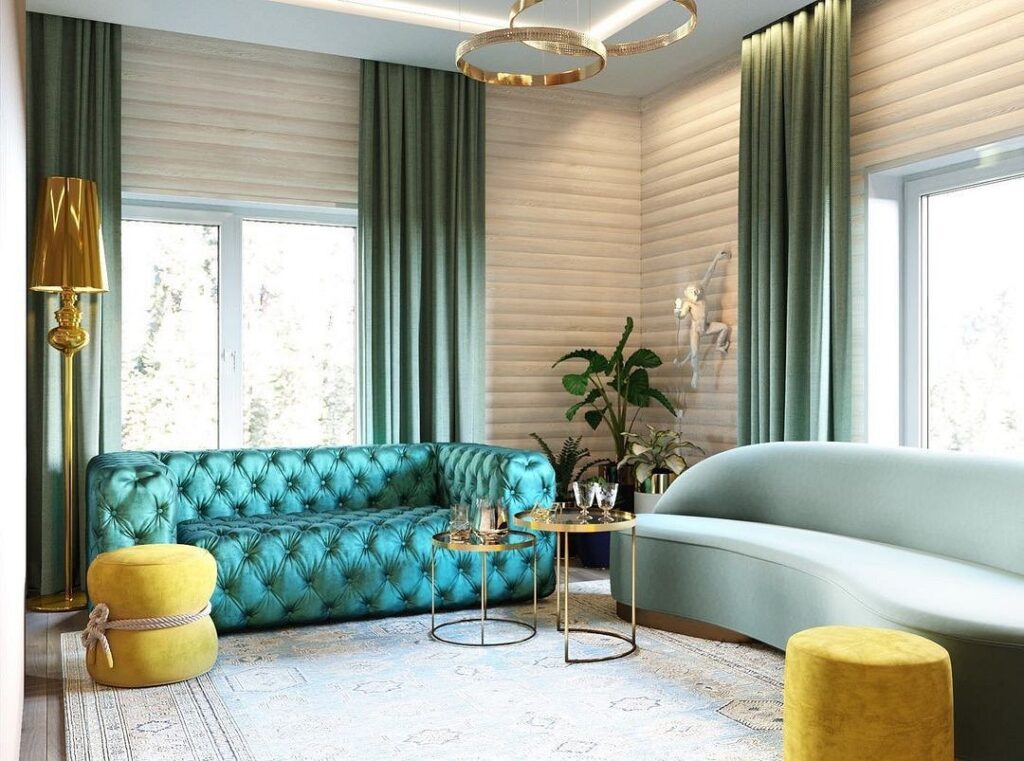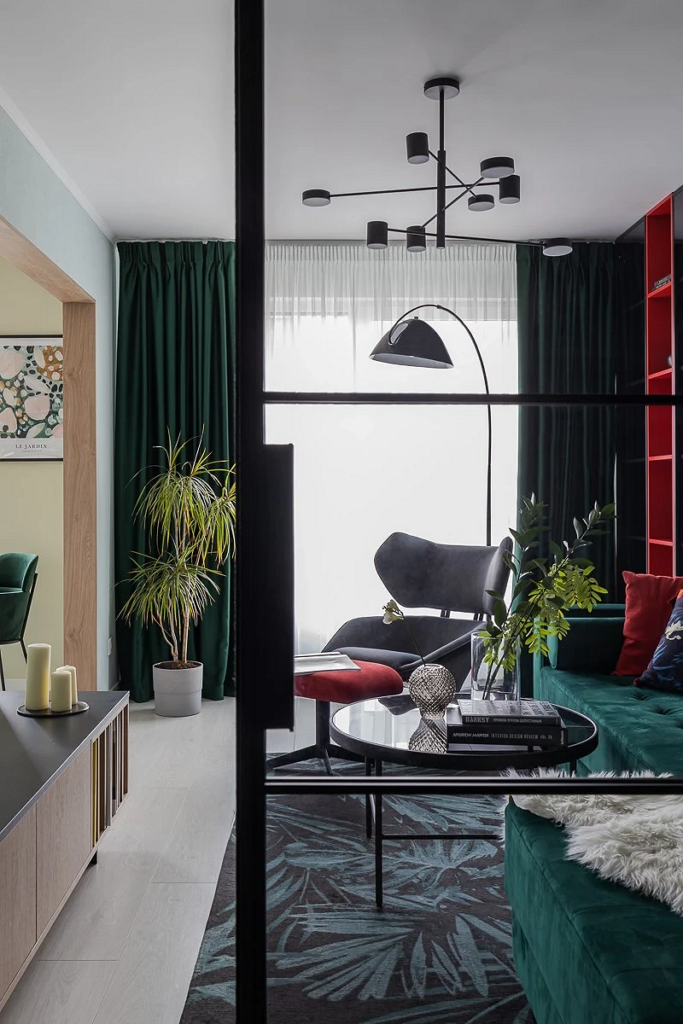Correctly selected textiles can transform any room. They can become a bright accent or a subtle backdrop, break up a monochromatic palette, or complement a diverse range of colors. We explain what to consider when decorating windows and show how green curtains look in different rooms with examples.
Variety of Shades

“Greening” the interior has been a solid trend in recent years. The more time we spend at home, the more we want to make our space within four walls feel fresh or, conversely, calming. Green color achieves both effects. To surround yourself with greenery inside an apartment, you don’t even need to buy flowers – just update your textiles, like hanging new curtains. The main advantage of this color is its versatility. In the color wheel, it sits between yellow and blue, and depending on the undertone, can be cool or warm. It evokes different associations: from tropical brightness to a walk in a quiet forest.
The variety of shades creates different decorating effects:
- Light green, lime, and chartreuse invigorate and energize.
- Grass green is associated with nature and creates a positive mood.
- Mint refreshes and has a stimulating effect.
- Olive helps focus, sets the mood for work, and distracts from hustle and bustle. It’s often used in rooms for hyperactive children.
- Emerald, malachite, and bottle green calm and soothe.
- Blue-green has a neutralizing effect on the psyche and is usually used in the bedroom.
- Marsh green in large amounts can cause gloom and even anxiety.





Choosing Curtains
Besides the right shade, other aspects are important when choosing textiles for windows.

- Material. Thick fabrics are suitable for bedrooms and work well with dark, noble shades of green (malachite, emerald, pine, etc.). Lighter curtains, like organza or cotton, are better for kitchens.
- Lighting. The general rule “dark reduces, light enlarges” also applies to curtain color. Light curtains made of flowing fabric visually make a dark room with small windows more spacious, while deep dark-colored drapes are suitable for blocking out light.
- Accent or backdrop. Decide the role window decor will play in your room’s interior. If it becomes the main color spot in the room, then finishing and furniture should be as neutral as possible. If, on the contrary, curtains only complement the overall color scheme and should not draw attention, opt for muted shades.
- Orientation. For north-facing windows, warm shades make the interior cozier; for south-facing, prefer cool tones.
- Combination with other colors. When choosing curtains, understand in advance which other interior elements they will match. For example, furniture items, other textiles, or finishes of a neutral shade of the same color can serve as connecting elements. Successful combinations with green include deep blue, white, gray, cool brown, yellow, blue, beige.




Options for Each Room
Now, let’s look at the use of green curtains in the interiors of different rooms.
Green Curtains in the Living Room Interior

The living room offers a wide field for experimentation. Here you can use any color variations and play with the length and texture of the textiles: both minimalist solid curtains and multi-layered compositions of different types of fabric look equally appropriate.
When choosing, consider the room’s style and overall color palette. For example, contemporary styles predominantly use full-length draperies in neutral shades, classic style implies expensive fabrics with draping and deep tones, and Provence features neat curtains with floral patterns.





Emerald curtains look elegant and beautiful in the living room interior. This shade is associated with prosperity and comfort, and in the room’s space, it helps to effectively highlight various details, becoming a luxurious backdrop for furniture or decor.
However, overdoing it with the emerald hue is risky — in large amounts, it can overwhelm all other colors with its depth and make the living room too dark. Therefore, it’s better to use it sparingly, as an accent. In this case, the window textiles should match in color with 1-2 elements in the living room. These could be sofa cushions, a throw, plants, a chair, or a rug.




Kitchen
In the kitchen, it’s especially important to be mindful of the color palette.

Fresh cool tones with a hint of blue or green can help curb overeating, while warm yellow-green shades, on the contrary, stimulate appetite. For texture, prefer simple and light fabrics (cotton, linen) and sheer curtains. Curtains can be full-length or up to the windowsill — or combine both. A popular option is roller or Roman shades.




Bedroom
Green curtains in a bedroom interior shield from bright light and aid relaxation.

For this room, any unobtrusive variations, light or dark, will work well based on the overall color scheme. Here, full-length heavy drapes made of dense fabrics like velvet or satin can look particularly stunning.




If the bedroom faces the sunny side, you can “soften” the windows with cool shades: blue-green, pine, dark emerald. If the room is lacking in warmth and light, enliven the interior with any undertones that include yellow.
An interesting design approach is to combine deep green with warm natural textures of wood or brick, as well as with light textiles. This creates a very cozy and relaxing interior.




Children’s Room
Any natural shades, including green, are suitable for a child’s room.

Green simultaneously invigorates and soothes, creates a positive atmosphere, and aids concentration. Moreover, it’s a gender-neutral color, so it’s a good choice for those who want to avoid traditional boys’ or girls’ colors, as well as for decorating a room for children of different genders.
Since children are active and fidgety, choose curtains made from eco-friendly but easy-care fabrics. In this case, blended materials, including those with dirt-repelling or anti-vandal treatments, are appropriate. If you’re worried that a child might pull down a curtain along with the rod, replace long draperies with Roman or roller shades.
In terms of design, they can be anything: solid-colored, with a subtle pattern, striped or polka-dotted, two-toned. The main thing is that the textile harmonizes with the rest of the palette.




Suitable Styles
Since we’re talking about a neutral natural color, it will be appropriate in almost any style, except perhaps pure high-tech, which is now rare.

If you’re not assembling a strict monochromatic palette (like gray-white-black or beige), colorful curtains will find their place in the interior. They look especially good in the following styles:
- Eco and Boho. The eco-direction already implies the use of natural colors, so such curtains can complement both the finish in the same color and indoor plants (which there are likely to be many) or small bright decor.
- Classical and Neoclassical. Traditional interiors suggest a noble neutral palette. Complex shades like emerald or bottle green complement it, especially if there is a lot of wood or marble in the room.
- Contemporary. Modern design sets no color restrictions, as long as they are deep, pleasing to the eye, and not acidic shades.
- Minimalism. Many find this style too austere, so you can add warmth and color with olive, blue-green, or pistachio textiles.










Leave feedback about this